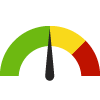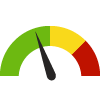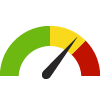Education & Lifelong Learning
Learning allows everyone to be productive citizens, self-sufficient and ready for life. Respect for and access to all types of educational opportunities throughout life equips us with the ability to learn, realize earning potential, think, and to access information in order to make effective decisions, while enriching our understanding of our diverse world.
Graduating from high school, higher education and formal training, imply necessary skills for employment and better opportunities, social responsibility and economic self-sufficiency.
A scale score is the student’s overall numerical score on a continuous scale (from approximately 2000-3000) that increases across grade levels, used to illustrate students’ current level of achievement and their growth over time. When combined together across a student population, scale scores can also describe school- and district-level changes in performance, as well as reveal gaps in achievement among different groups of students. Based on their scale scores, students fall into one of 4 categories of performance called achievement levels defined by specifications for what knowledge and skills students display at each level:
- Level 4 = The student has exceeded the achievement standard and demonstrates advanced progress toward mastery of the knowledge and skills needed for likely success in future coursework.
- Level 3 = The student has met the achievement standard and demonstrates progress toward mastery of the knowledge and skills needed for likely success in future coursework.
- Level 2 = The student has nearly met the achievement standard and may require further development to demonstrate the knowledge and skills needed for likely success in future coursework.
- Level 1 = The student has not met the achievement standard and needs substantial improvement to demonstrate the knowledge and skills needed for likely success in future coursework.
As college debt becomes higher, university student retention may become harder. The student attrition rate estimates the percentage of full-time, degree-seeking cohort freshman who entered the prior fall but are no longer enrolled.
The graduation rate for higher education in Nevada is a percentage of the number of students entering the institutions as undergraduate full-time, first-time, degree-seekers in a cohort year who complete their program within 150% of normal time (6 years for bachelor’s degrees, 3 years for associate’s degrees, 1.5 years for certificates).
Enrollment, technology and specialized needs signify access to educational opportunities to be ready for life; while parental and community involvement enhance the student learning experience.
Graduating Functional literacy, GED completion, college-readiness, quality libraries and needed technology are some of the keys to helping individuals participate as responsible citizens and realize their fullest potential.
Indicator Gauge Icon Legend
Legend Colors
Red is bad, green is good, blue is not statistically different/neutral.
Compared to Distribution
 the value is in the best half of communities.
the value is in the best half of communities.
 the value is in the 2nd worst quarter of communities.
the value is in the 2nd worst quarter of communities.
 the value is in the worst quarter of communities.
the value is in the worst quarter of communities.
Compared to Target
 meets target;
meets target;  does not meet target.
does not meet target.
Compared to a Single Value
 lower than the comparison value;
lower than the comparison value;
 higher than the comparison value;
higher than the comparison value;
 not statistically different from comparison value.
not statistically different from comparison value.
Trend

 non-significant change over time;
non-significant change over time; 
 significant change over time;
significant change over time;  no change over time.
no change over time.
Compared to Prior Value
 higher than the previous measurement period;
higher than the previous measurement period;
 lower than the previous measurement period;
lower than the previous measurement period;
 no statistically different change from previous measurement period.
no statistically different change from previous measurement period.
Child Care and Early Education
Child Care Centers County: Washoe
Child Care Centers County: Washoe



Child Care Centers State: Nevada
Child Care Centers State: Nevada


Price of Licensed Child Care County: Washoe
Price of Licensed Child Care County: Washoe


Education Level of Adults
People 25+ with a Bachelor's Degree or Higher County: Washoe
People 25+ with a Bachelor's Degree or Higher County: Washoe





People 25+ with a Bachelor's Degree or Higher State: Nevada
People 25+ with a Bachelor's Degree or Higher State: Nevada



People 25+ with a High School Diploma or Higher County: Washoe
People 25+ with a High School Diploma or Higher County: Washoe





People 25+ with a High School Diploma or Higher State: Nevada
People 25+ with a High School Diploma or Higher State: Nevada



Veterans with a Bachelor's Degree or Higher County: Washoe
Veterans with a Bachelor's Degree or Higher County: Washoe




Veterans with a Bachelor's Degree or Higher State: Nevada
Veterans with a Bachelor's Degree or Higher State: Nevada


Veterans with a High School Diploma or Higher County: Washoe
Veterans with a High School Diploma or Higher County: Washoe





Veterans with a High School Diploma or Higher State: Nevada
Veterans with a High School Diploma or Higher State: Nevada



High School and College Graduation
High School Graduation County: Washoe
High School Graduation County: Washoe






High School Graduation State: Nevada
High School Graduation State: Nevada




High School and College Graduation
Washoe County School District Graduates Completing Nevada System of Higher Education Remedial Coursework
Washoe County School District Graduates Completing Nevada System of Higher Education Remedial Coursework County: Washoe
Washoe County School District Graduates Completing Nevada System of Higher Education Remedial Coursework County: Washoe


High School and College Graduation
Nevada System of Higher Education (NSHE) Graduation Rates: 2-Year Institutions
Nevada System of Higher Education (NSHE) Graduation Rates: 2-Year Institutions State: Nevada
Nevada System of Higher Education (NSHE) Graduation Rates: 2-Year Institutions State: Nevada

High School and College Graduation
Nevada System of Higher Education (NSHE) Graduation Rates: 4-Year Institutions
Nevada System of Higher Education (NSHE) Graduation Rates: 4-Year Institutions State: Nevada
Nevada System of Higher Education (NSHE) Graduation Rates: 4-Year Institutions State: Nevada

Households and Internet Access
Households with an Internet Subscription County: Washoe
Households with an Internet Subscription County: Washoe





Households with an Internet Subscription State: Nevada
Households with an Internet Subscription State: Nevada



Households and Internet Access
Households with One or More Types of Computing Devices
Households with One or More Types of Computing Devices County: Washoe
Households with One or More Types of Computing Devices County: Washoe





Households with One or More Types of Computing Devices State: Nevada
Households with One or More Types of Computing Devices State: Nevada



Persons with an Internet Subscription County: Washoe
Persons with an Internet Subscription County: Washoe





Persons with an Internet Subscription State: Nevada
Persons with an Internet Subscription State: Nevada



Library System
Library System Collection Turnover County: Washoe
Library System Collection Turnover County: Washoe


Library System Patron Visitors Per Capita County: Washoe
Library System Patron Visitors Per Capita County: Washoe


Special Education and English Learners
Students Who are English Learners County: Washoe
Students Who are English Learners County: Washoe



Students Who are English Learners State: Nevada
Students Who are English Learners State: Nevada


Special Education and English Learners
Students with an Individual Education Program
Students with an Individual Education Program County: Washoe
Students with an Individual Education Program County: Washoe



Students with an Individual Education Program State: Nevada
Students with an Individual Education Program State: Nevada


Student Proficiency
4th Grade Students Proficient in Math County: Washoe
4th Grade Students Proficient in Math County: Washoe




4th Grade Students Proficient in Math State: Nevada
4th Grade Students Proficient in Math State: Nevada


4th Grade Students Proficient in Reading County: Washoe
4th Grade Students Proficient in Reading County: Washoe




4th Grade Students Proficient in Reading State: Nevada
4th Grade Students Proficient in Reading State: Nevada


8th Grade Students Proficient in Math County: Washoe
8th Grade Students Proficient in Math County: Washoe




8th Grade Students Proficient in Math State: Nevada
8th Grade Students Proficient in Math State: Nevada


8th Grade Students Proficient in Reading County: Washoe
8th Grade Students Proficient in Reading County: Washoe




8th Grade Students Proficient in Reading State: Nevada
8th Grade Students Proficient in Reading State: Nevada


Student Proficiency
Students Proficient in English Language Arts (CRT): Grades 3-8
Students Proficient in English Language Arts (CRT): Grades 3-8 County: Washoe
Students Proficient in English Language Arts (CRT): Grades 3-8 County: Washoe



Students Proficient in English Language Arts (CRT): Grades 3-8 State: Nevada
Students Proficient in English Language Arts (CRT): Grades 3-8 State: Nevada


Students Proficient in Math (CRT): Grades 3-8 County: Washoe
Students Proficient in Math (CRT): Grades 3-8 County: Washoe



Students Proficient in Math (CRT): Grades 3-8 State: Nevada
Students Proficient in Math (CRT): Grades 3-8 State: Nevada


Washoe County School District (WCSD) Statistics
Washoe County School District (WCSD) Statistics
Washoe County School District GASB 34 Government Activity Instruction-only Expenditure Dollars
Washoe County School District GASB 34 Government Activity Instruction-only Expenditure Dollars County: Washoe
Washoe County School District GASB 34 Government Activity Instruction-only Expenditure Dollars County: Washoe


Student-to-Teacher Ratio County: Washoe
Student-to-Teacher Ratio County: Washoe






Student-to-Teacher Ratio State: Nevada
Student-to-Teacher Ratio State: Nevada




Washoe County School District (WCSD) Statistics
Washoe County School District GASB 34 Guidelines Activity Total Expenditure Dollars
Washoe County School District GASB 34 Guidelines Activity Total Expenditure Dollars County: Washoe
Washoe County School District GASB 34 Guidelines Activity Total Expenditure Dollars County: Washoe


Washoe County School District (WCSD) Statistics
Washoe County School District Operating Statistics: Enrollment
Washoe County School District Operating Statistics: Enrollment County: Washoe
Washoe County School District Operating Statistics: Enrollment County: Washoe


Washoe County School District (WCSD) Statistics
Washoe County School District Per-Pupil Expenditures
Washoe County School District Per-Pupil Expenditures County: Washoe
Washoe County School District Per-Pupil Expenditures County: Washoe


Washoe County School District (WCSD) Statistics
Washoe County School District Population
Washoe County School District Population County: Washoe
Washoe County School District Population County: Washoe


Washoe County School District (WCSD) Statistics
WCSD Operating Statistics: Primary Government Cost Per Pupil
WCSD Operating Statistics: Primary Government Cost Per Pupil County: Washoe
WCSD Operating Statistics: Primary Government Cost Per Pupil County: Washoe


Washoe County School District (WCSD) Statistics
WCSD Operating Statistics: Primary Government Pupil to Teacher Ratio
WCSD Operating Statistics: Primary Government Pupil to Teacher Ratio County: Washoe
WCSD Operating Statistics: Primary Government Pupil to Teacher Ratio County: Washoe


Washoe County School District (WCSD) Statistics
WCSD Operating Statistics: Students Receiving Free or Reduced-Price Meals
WCSD Operating Statistics: Students Receiving Free or Reduced-Price Meals County: Washoe
WCSD Operating Statistics: Students Receiving Free or Reduced-Price Meals County: Washoe


Students with Free or Reduced Lunch
Students Eligible for the Free Lunch Program County: Washoe
Students Eligible for the Free Lunch Program County: Washoe






Students Eligible for the Free Lunch Program State: Nevada
Students Eligible for the Free Lunch Program State: Nevada






